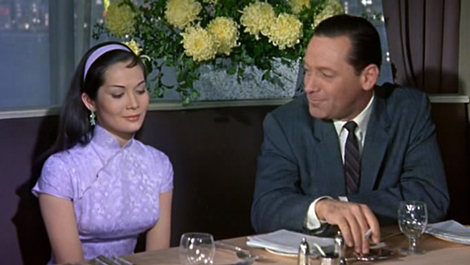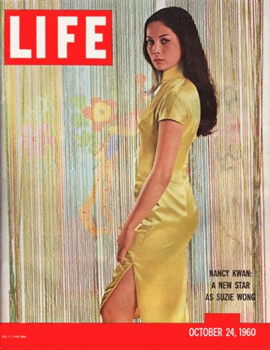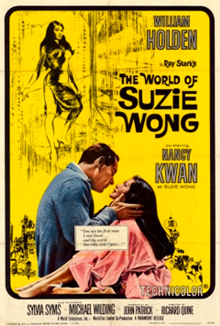Reviewed by Glenn Erickson
Here's a big surprise - for decades I've avoided The World of Susie Wong, under the mistaken illusion that it was a typical-for-1960 interracial romance soap opera. I expected to see a parade of racist and sexist situations. The name "Suzie Wong", after all, has become synonymous with the image of the Hong Kong good-time girl, a plaything for foreign visitors. Now I believe the trade has shifted to other Southeast Asian countries, and has been renamed 'sex tourism.' The tight Cathay-fashion dress favored by Suzie Wong types, slit to the hip on both sides, was also called a Suzie Wong dress for quite a few years.
As it turns out, the intelligent and fair-minded romantic drama The World of Susie Wong acknowledges the cultural hypocrisy without adding to it. The Ray Stark production builds on audience expectations laid down by films like Love is a Many-Splendored Thing -- a handsome Anglo (William Holden in both films) falls in love with an exotic woman of the East. In this case the dream girl is a full-on prostitute; the understanding hero warms to her despite knowing she's sleeping with other men. That storyline must have dropped a lot of flags in the Hollywood offices of the Production Code. A man cozies up to a 'fallen woman' -- of another race -- and she isn't hit by lightning or swallowed up by a volcano. Wong became the second film of 1960 to present a prostitute as a main character, without apology -- the other was United Artists' Never on Sunday. Advertised as 'suggested for Adults Only', Susie Wong introduced an impressive new star to the screen, Nancy Kwan. She and co-star William Holden make convincing lovers.

Office worker Robert Lomax (William Holden) arrives in Hong Kong determined to become a painter. He installs himself in a disreputable hotel and asks for social introductions from O'Neill (Laurence Naismith), whose daughter Kay (Sylvia Sims) takes an immediate interest in Robert. But the painter is fascinated by Suzie Wong (Nancy Kwan), the top prostitute in the hotel's bar. Refusing to accept her favors even when offered for free, Robert finds Suzie a proper subject for his colorful paintings. But pressures soon come to bear. Kay pursues Robert more aggressively while straying businessman Ben Marlowe (Michael Wilding) openly asks Suzie to become his 'steady girl.' Suzie is furious that Robert prefers to concentrate on his paintings before taking on more responsibilities. Despite his reluctance and her lifestyle, the two are inexorably drawn together. What will the penniless Robert give up to keep Suzie as his own?
Susie Wong begins cleverly, making us think that the Chinese beauty Robert meets on the Hong Kong ferry is a smart little flirt who speaks in broken English. In reality Suzie is a playful master of her trade, an expert at keeping a dozen customers on the hook at the same time. She lets down her guard only when she finds that Robert has integrity. He treats her like a lady even in the presence of his Anglo peers, which does little for him socially. Suzie breaks the code of her profession by offering herself to Robert simply because she likes him. At first this development seems to pander to Anglo fantasies. What lonely guy hasn't taken a cue from old Hollywood pictures, and dreamed of being so desirable that a prostitute wants to sleep with him free of charge? Fortunately The World of Susie Wong soon leaves situations like that far behind. That Robert Lomax remains calm when other men sleep with the woman he loves was unheard-of in 1960, when real men were by definition possessive. Perhaps to compensate, the movie includes a scene in which Robert beats up a sailor who has struck Suzie in the mouth.

Love is a Many-Splendored Thing exploited Hong Kong as a colorful travelogue background, but Susie Wong's more numerous and integrated location scenes eventually convey a real flavor of the city. As Robert and Suzie walk the streets and markets, Geoffrey Unsworth's camera pauses to observe much more detail. True, the interiors and some street scenes were filmed in studios in London, but the matching is excellent. George Duning's impressive music score animates the fairly lengthy show at all times -- we never feel that an oriental atmosphere is being pushed at us.
William Holden was at this time a top star commanding a major profit cut. His influence was almost as powerful as the producer's. In this movie and his subsequent The Counterfeit Traitor the pace is slowed down considerably. Some critics found Holden too subdued, leading one to wonder if they expected Anglo male heroes to assert themselves at all times, preferably with their fists. When Robert Lomax shouts that he's pushing 40 we realize how much Holden looks his age, yet has lost little of his attractiveness. The nineteen-year-old Nancy Kwan was 'discovered' quite quickly in a London ballet school, to replace France Nuyen (who would cashe her rain check with Holden in the disappointing Satan Never Sleeps.). Ms. Kwan's performance is truly impressive -- she shows a facility with moods and shifts of tone, and projects mischief and integrity in equal doses. Kwan carries the film's heavy scenes as well as the frivolous ones, as when she puts on a terrific dance in the hotel bar.
Richard Quine's direction is fluid and expressive, and well attuned to the graces of his two stars. Quine had handled everything Columbia could throw at him in the 1950s, until a dearth of good material slowed him down. He guides the storyline smoothly through its shifts from comedy to heavy drama. Hollywood movies were talking racial equality while still honoring the old double standard, and in the last act of Suzie Wong we become concerned that some Victorian excuse will be used to keep the races romantically separate. Love is a Many-Splendored Thing plays that particular card. 1

Sylvia Sims has the unenviable role of the Brit beauty convinced that Lomax will find his way back to a socially approved relationship with her. Michael Wilding was always convincing when playing a heel; when he shows his true colors he comes off as so repulsive that there's no reason for Holden's character to beat him up. Bernard Cribbins has a quick scene as a sailor on the make. What strikes us most positively about The World of Susie Wong is that, fifty years down the line, it need not make apologies for its dated aspects. The truth of Third World prostitution is if anything far more despicable now; the movie respects its characters and surely did its part to influence thinking in a positive way.
The fact that Suzie Wong was produced in England surely accounts for its liberalized attitudes - sex out of wedlock is not a Fate Worse than Death. Screenwriters John Patrick and Paul Osborn adapted Richard Mason's book. 3 Paul Osborn put together East of Eden and Wild River for Elia Kazan and also wrote or worked on the screenplays for sensitive films like The Yearling and Portrait of Jennie. Osborn went on a mixed-race romance streak in the late 1950s, having both Sayonara and South Pacific on his résumé. 2
The Warner Archive Collection DVD-R of The World of Susie Wong is an older Paramount DVD reissued by special arrangement. The transfer is quite good for Standard Def, with bright colors and pleasant skin tones. As noted above, George Duning's music is pleasant on the ears -- no screechy title song as with Many-Splendored Thing. Although it's nice to have this show back in print, fans would surely rather see these quality pictures reissued as Blu-rays.

Fans of Nancy Kwan (that includes most everyone who sees Suzie Wong) should know about the affectionate biographical documentary To Whom It May Concern: Ka Shen's Journey. The story of her hiring for this film and her further adventures in the movie game are the stuff of movie legend: Nancy Kwan went from unknown to international star in one fell swoop. A biographical musical play was written for Kwan, telling the story of her life through a contrast with her alter ego, Suzie.
On a scale of Excellent, Good, Fair, and Poor,
The World of Susie Wong rates:
Movie: Excellent
Video: Very Good
Sound: Very Good
Supplements: none
Deaf and Hearing Impaired Friendly?
Yes; Subtitles: English
Packaging: Keep case
Reviewed: December 5, 2013
Footnote:
1. Yes, I know that the true story Many-Splendored is based on, finished in much the same tragic way.
Return
2. Sex for sale continued to be big box office in the 1960s. After doing so much to soften Production Code edicts in Hollywood, Billy Wilder followed with two comedies that took a bawdy attitude toward prostitution. The big hit Irma La Douce is amusing and looks great, but is not among the director's best efforts. Wilder's follow-up Kiss Me, Stupid was unfairly condemned as the epitome of bad taste circa 1965. Even in today's climate of raunch and scatology, I still hear someone occasionally commenting on the film's vulgarity.
Return
3. Savant's ignorance is corrected by respected correspondent "B", 12.09.13:
Dear Glenn: It's worth noting, or clarifying, that The World of Susie Wong is not simply adapted from Richard Mason's book, it's also adapted from Paul Osborn's hit dramatization of Mason's novel. The play ran for fifteen months on Broadway. William Shatner played Lomax and France Nuyen played Suzie; Josh Logan directed. David Merrick was the show's primary presenter, but Ray Stark's Seven Arts Productions was also financially and creatively involved in the Broadway production.
In his memoir, can-do producer Edward S. Feldman, who worked for Stark in various capacities back in the Seven Arts days, briefly discussed the very difficult shoot. France Nuyen was weathering personal problems, and she began to put on weight. Stark lost patience with this and fired her after six or seven weeks of production, bringing in the almost wholly inexperienced Nancy Kwan. Much of the film then had to be re-shot, of course, including an extensive amount of the location work. This gave Stark the opportunity to fire director Jean Negulesco (with whom he was also losing patience) and hire Richard Quine, who, per Feldman, really did shoot almost all of the finished film.
I liked your review. You approached it from a good angle. Best, Always. -- B.
Return

DVD Savant Text © Copyright 2013 Glenn Erickson
See more exclusive reviews on the Savant Main Page.
Reviews on the Savant main site have additional credits information and are often updated and annotated with reader input and graphics.
Also, don't forget the
2011 Savant Wish List.
T'was Ever Thus.
Return to Top of Page
|

